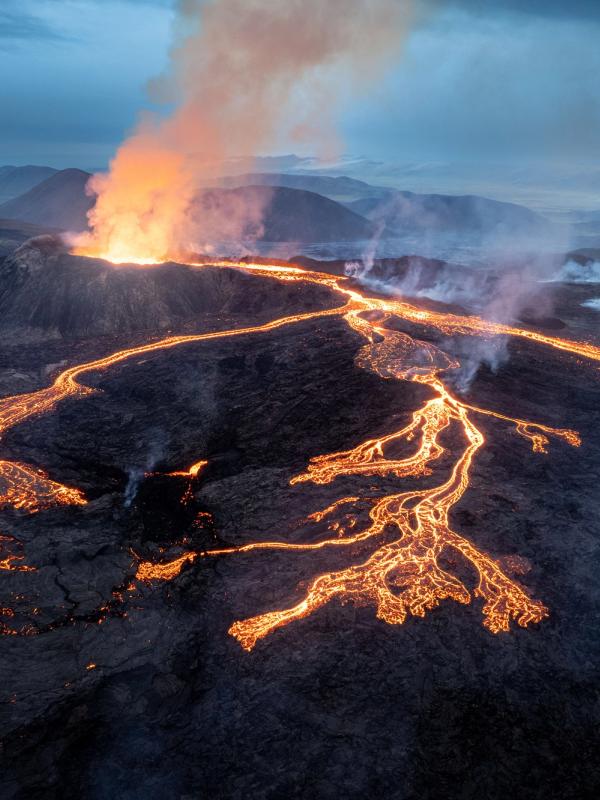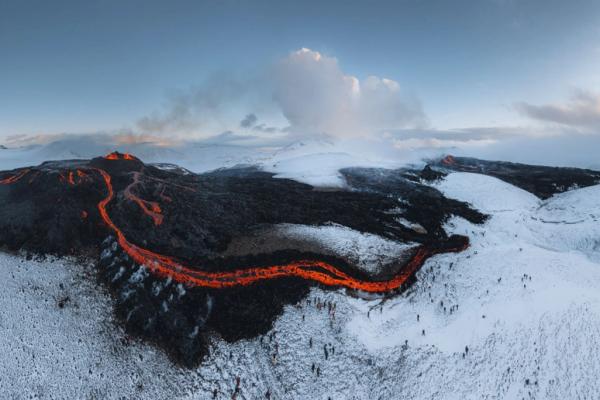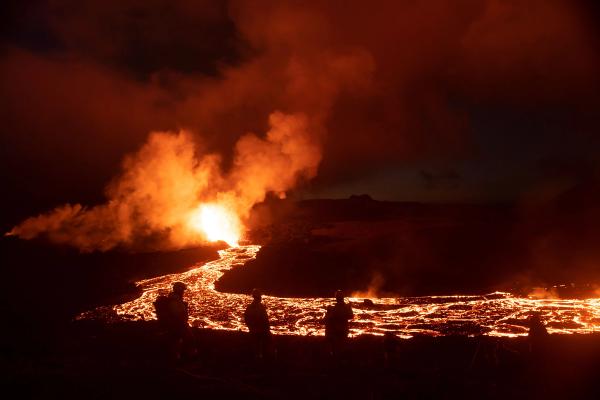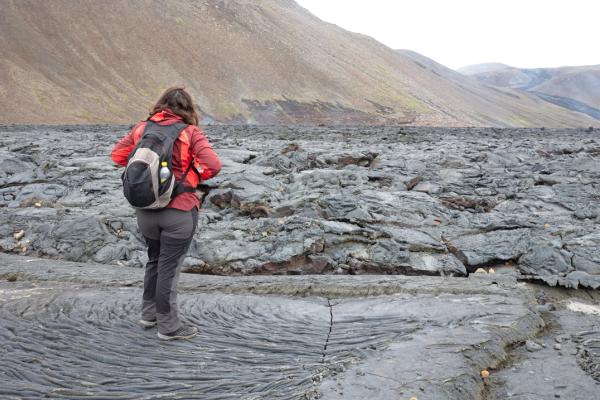
Adventure Awaits: Fagradalsfjall Volcano Exploration
Picture yourself standing on the edge of an active volcano, witnessing the raw power of nature as molten lava flows and fountains erupt before your eyes. Welcome to Fagradalsfjall, a geological marvel located on the Reykjanes Peninsula in Iceland. In this blog post, you will explore Fagradalsfjall volcano’s geology, history, and eruption events while learning essential safety precautions for visiting the site. Let’s embark on a thrilling journey to uncover the secrets of this awe-inspiring volcanic wonder.
Since October 2023, the Reykjanes area has been experiencing heightened seismic activity, which could potentially signal an impending volcanic eruption. For the latest updates on this matter, please refer to Visit Reykjanes.
Key Takeaways
- Explore Fagradalsfjall Volcano in Iceland to witness the 2021 eruption and its dynamic nature.
- Learn about the geology behind eruptions, their impact on environment, and safety precautions for visiting.
- Plan your visit with tailored itineraries from Nordic Visitor, taking into account weather conditions between October, April.
Understanding Fagradalsfjall Volcano

Situated in an unpopulated area on the Reykjanes Peninsula, just 30 kilometers from Reykjavik, Fagradalsfjall volcano offers a unique opportunity to witness the power of volcanic activity up close. The Fagradalsfjall volcanic system erupted on March 19, 2021, producing fresh lava that flowed across the landscape, marking the first eruption in the area after 800 years of dormancy.
This effusive fissure eruption began, capturing the attention of scientists and tourists alike, as it showcases the dynamic nature of volcanic eruptions, lava flows, and fountains. As the lava flowed, it further demonstrated the power and beauty of this natural phenomenon.
The Geology Behind the Eruption
The eruption of Fagradalsfjall Volcano is the result of a complex interplay between magma flow and plate tectonic activity, as it sits right on the Mid-Atlantic Ridge, the boundary between the North American plate and the Eurasian plate. Tectonic activity plays a significant role in the eruption, as the movement and interaction of these plates exert stress and pressure on the Earth’s crust, leading to the formation and movement of magma.
Magma formation in the region is unique, as melts sourced from the shallowest mantle rise directly to the surface, bypassing the typical magma chamber in the Earth’s crust. This process leads to the eruption of spectacular lava fountains and flows in the area.
Previous Eruptions and Their Impact
Fagradalsfjall has a history of eruptions, with the most recent one in 2021 being followed by a weeks-long event in August 2022 and the current eruption in July 2023. At one point during the eruption, six craters were erupting concurrently, producing flowing lava that spread across the landscape. The impacts of previous eruptions have been notably limited, as they occurred in unpopulated regions, with the primary hazard being the lava flows themselves.
Experiencing the Fagradalsfjall Eruption

Witnessing the Fagradalsfjall eruption is an experience of a lifetime, as it offers a rare opportunity to observe:
- Lava flows
- Fire fountains
- Pulsating activity
- Steady outflow of lava
- Periods of inactivity
Visitors can observe the ever-changing landscape shaped by the volcanic activity and volcanic gases of an active volcano.
Observing Lava Flows and Fountains
The thin and low viscosity basaltic lava at Fagradalsfjall flows easily, creating a lava flow that results in an effusive eruption and forms a dynamic landscape that changes daily as the lava piles up and spreads across valley floors. The lava fountains at the eruption site are caused by the forceful ejection of molten lava from the ground, providing a mesmerizing display of nature’s raw power. The lava flow rate plays a significant role in shaping this ever-evolving landscape.
As the eruption progresses, the characteristics of the lava flows and fountains can change. The pulsating activity with fire fountains, the steady outflow of lava, and the quiet periods with no activity showcase the diverse nature of volcanic eruptions. The composition of the lava may also change over time, adding another layer of complexity to the eruption.
Monitoring Volcanic Activity
Public safety at Fagradalsfjall hinges on monitoring volcanic activity, enabling experts to detect activity fluctuations and anticipate potential eruptions. Organizations such as the Icelandic Meteorological Office, a group of geology experts, and ICE-SAR (Icelandic Association for Search and Rescue) are responsible for monitoring the volcanic activity at Fagradalsfjall.
Data gathered from monitoring the volcano is made available to the public through various initiatives, such as CIEST2, HOTVOLC, and MOUNTS, all supported by the institute of earth sciences. This allows everyone to stay informed about the ongoing volcanic activity and make informed decisions about visiting the eruption site.
Safety Precautions for Visiting the Eruption Site

When planning a visit to Fagradalsfjall, safety should be your top priority. At present, it is not advisable to visit the latest eruption site on foot due to potential hazards, and it is highly hazardous to touch or walk on solidified lava at Fagradalsfjall.
Instead, you can explore other volcanic sites on the Reykjanes Peninsula or take a helicopter tour over the eruption site for an aerial view of the activity.
Hiking Safely to the Eruption Site

If you are considering hiking to the eruption site, prioritize safety and be ready for sudden changes in weather or volcanic activity. The Meradalir route (or Path E) from the car park beside road 427 is recommended for hiking to the Litli-Hrútur eruption site, leading to the volcano viewing point. However, new fissures may open unexpectedly, and toxic gases may accumulate in the area depending on the wind direction, making the site less safe for children and individuals with asthma or other underlying health conditions.
The duration of the hiking trail to the viewing point near the volcano is approximately 5-8 hours. While hiking, heed local authorities’ instructions for your safety. They may close or redirect the route at any time due to weather changes or shifts in the eruption’s course. Adequate clothing, footwear, and supplies are essential for a safe and enjoyable hike to the eruption site.
Helicopter Tours: A Safer Alternative
For those who prefer a safer and more comfortable way to experience the Fagradalsfjall eruption, helicopter tours offer an excellent alternative. Companies such as Nordic Helicopter Tours, Norðurflug Helicopter Tours, and Volcano Heli offer helicopter tours of the Fagradalsfjall eruption, providing an aerial view of the mesmerizing volcanic activity.
The duration of a helicopter tour of the Fagradalsfjall eruption typically ranges from 20 to 60 minutes, depending on the tour package, with prices starting at approximately $685+. Soaring above the eruption site, you can witness the breathtaking spectacle of molten lava flowing across the landscape, all from the safety and comfort of a helicopter.
Exploring the Reykjanes Peninsula
The Reykjanes Peninsula is a geological wonderland characterized by immense lava fields, volcanoes, and heightened geothermal activity. This region offers a unique opportunity to discover Iceland’s volcanic landscape beyond Fagradalsfjall, as it is home to several notable shield volcanoes and fissures capable of producing effusive eruptions.
Icelandic Volcanoes and Lava Fields
Iceland is a land of fire and ice, with a rich volcanic history that has shaped its unique landscape. The Reykjanes Peninsula, in particular, is the most active region in Iceland in terms of volcanoes and lava fields. Some of the most renowned volcanoes in the country include:
- Eyjafjallajökull
- Katla
- Snæfellsjökull
- Askja
- Krafla
The formation of Icelandic lava fields is a result of volcanic activity, where molten rock, or magma, erupts from a volcano and flows across the land surface. The lava then cools and solidifies, resulting in vast fields of hardened lava. Some of the notable lava fields in the Reykjanes Peninsula include the Ögmundarhraun lava field and the Fagradalsfjall volcano lava fields.
These lava fields are home to unique vegetation, such as:
- algae
- lichens
- mosses
- liverworts
These plants eventually support a variety of plants and animals as they evolve over time. Exploring these volcanic landscapes allows you to witness firsthand the incredible forces that have shaped Iceland’s dramatic scenery.
Natural History and Seismic Activity
The Reykjanes Peninsula has a fascinating natural history, shaped by immense lava fields, volcanoes, and heightened geothermal activity. It is situated directly on the Mid-Atlantic Ridge, the boundary between the Eurasian and North American tectonic plates, which plays a significant role in the volcanic and geothermal activity present on the peninsula.
The peninsula’s seismic activity history is also rich, with numerous reports of earthquake swarms and thousands of recorded earthquakes in the area. This tectonic activity, coupled with the peninsula’s connection to the Mid-Atlantic Ridge, results in frequent volcanic and seismic activity in the region.
Understanding the natural history and seismic activity of the Reykjanes Peninsula adds depth to your exploration of the volcanic landscapes in this breathtaking region. It provides a greater appreciation of the dynamic geological forces that continue to shape this stunning corner of Iceland.
Planning Your Visit to Fagradalsfjall
With so much to explore and experience, planning your visit to Fagradalsfjall and the surrounding Reykjanes Peninsula can be both exciting and overwhelming. To make the most of your trip, it is essential to consider factors such as the best time to visit, weather conditions, and transportation options.
Companies like Nordic Visitor can create a tailored itinerary for your Iceland volcano trip and take care of all the necessary arrangements, ensuring a smooth and unforgettable journey.
Best Time to Visit and Weather Conditions
The optimal time to visit Fagradalsfjall Volcano in Iceland is between October and April. Bear in mind that volcanic activity can be unpredictable, so always check the latest updates before organizing a visit. Weather conditions in Iceland can be quite variable, with relatively mild winters and cool summers. Storms and rain are frequent, so it is advisable to come prepared for these conditions, even if the weather appears to be good when starting your hike or tour.
The weather can also have an influence on the visibility of the Fagradalsfjall eruption. Cold and windy conditions can disperse the smoke and ash, reducing the visibility of the eruption, while heavy rain or fog can obstruct the view. Thus, following the weather forecast and seeking local guidance for the prevailing conditions is crucial when planning your visit.
Transportation and Parking Options
Transportation options to Fagradalsfjall include:
- Driving to Grindavik and then taking a bus to the trailhead leading to the eruption site
- Booking a bus transfer with a tour operator
- Helicopter tours for those who prefer a more comfortable and safer way to experience the Fagradalsfjall eruption.
Parking facilities are provided at the Fagradalsfjall eruption site, with two parking lots available, namely Parking P1 and Parking P2. Be aware that the car parks fill up quickly, and the area can be quite muddy after heavy rainfall. Planning your transportation and parking options ahead of time will ensure a seamless and enjoyable visit to the Fagradalsfjall eruption site.
Summary
In conclusion, exploring Fagradalsfjall Volcano and the Reykjanes Peninsula offers an incredible opportunity to witness the awe-inspiring power of nature, as well as gain a deeper understanding of the geological forces that shape our world. By taking the necessary safety precautions, staying informed about the latest volcanic activity, and planning your visit with care, you can embark on a thrilling journey to uncover the secrets of this breathtaking volcanic wonder.
